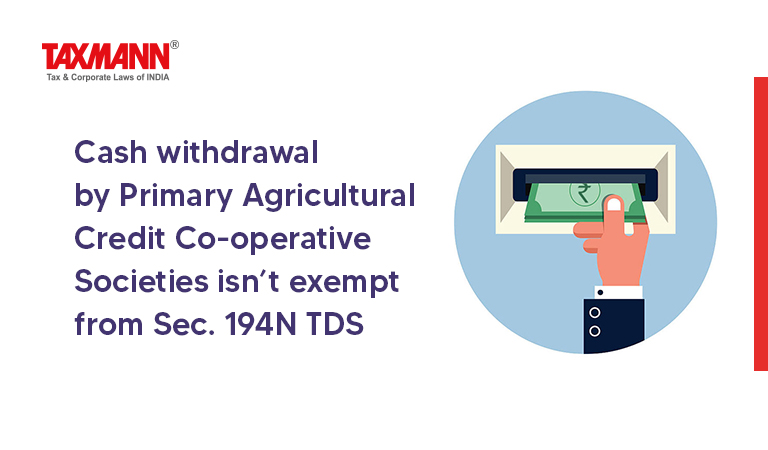Cash withdrawal by Primary Agricultural Credit Co-operative Societies isn’t exempt from Sec. 194N TDS
- Blog|News|Income Tax|
- 2 Min Read
- By Taxmann
- |
- Last Updated on 2 December, 2022

Case Details: Molasi Primary Agricultural Cooperative Credit Society Ltd. v. ITO - [2022] 145 taxmann.com 222 (Madras)
Judiciary and Counsel Details
-
- Dr. Anita Sumanth, J.
- C. Prakasam for the Petitioners.
- A.N.R. Jayaprathap, Junior Standing Counsel for the Respondent.
Facts of the Case
Assessee, a primary agricultural co-operative credit society engaged in advancing loans relating to the advancement of crops and fertilizers to the agriculturists and having accounts with R2 Banks. During the relevant assessment year, it withdrew cash over the limit prescribed under section 194N from the banks. The banks deducted TDS under section 194N on the amount of cash withdrawal.
The assessee filed a writ petition before the Madras High Court contending that the society was merely acting as a conduit between the banks and the agriculturists. Also, the cash withdrawn is not income in the hands of society, thus, there should not be any deduction of tax at source.
High Court Held
The High Court held that the objective of section 194N is to discourage cash withdrawals and move towards a cashless economy. The scheme of deduction of tax at source under section 194N also allows making application under section 197 if the assessee seeks the remedy of deduction of tax at nil/lower rate under various provisions of the Income-tax Act. However, section 194N is conspicuous by its absence therein, and does not figure in the list of such provisions.
Thus, it is clear that the requirements relating to compliance with section 194N are non-negotiable except with the specified exemptions mentioned therein in the section itself.
Any assessee falling outside the scope of the specified exemption list needs to obtain a specific exemption from the authority. The assessee may approach the competent authority in the Government seeking relief from the application of Section 194N.
Further, the High Court held that society is always entitled to seek credit for the taxes attributable to the income shown in the Income-tax return and any excess deduction would have to be refunded to it. Thus, the writ petition filed by the assessee was to be dismissed.
Disclaimer: The content/information published on the website is only for general information of the user and shall not be construed as legal advice. While the Taxmann has exercised reasonable efforts to ensure the veracity of information/content published, Taxmann shall be under no liability in any manner whatsoever for incorrect information, if any.

Taxmann Publications has a dedicated in-house Research & Editorial Team. This team consists of a team of Chartered Accountants, Company Secretaries, and Lawyers. This team works under the guidance and supervision of editor-in-chief Mr Rakesh Bhargava.
The Research and Editorial Team is responsible for developing reliable and accurate content for the readers. The team follows the six-sigma approach to achieve the benchmark of zero error in its publications and research platforms. The team ensures that the following publication guidelines are thoroughly followed while developing the content:
- The statutory material is obtained only from the authorized and reliable sources
- All the latest developments in the judicial and legislative fields are covered
- Prepare the analytical write-ups on current, controversial, and important issues to help the readers to understand the concept and its implications
- Every content published by Taxmann is complete, accurate and lucid
- All evidence-based statements are supported with proper reference to Section, Circular No., Notification No. or citations
- The golden rules of grammar, style and consistency are thoroughly followed
- Font and size that’s easy to read and remain consistent across all imprint and digital publications are applied




